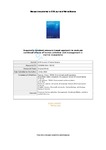A spatially resolved pressure-based approach to evaluate combined effects of human activities and management in marine ecosystems
| dc.contributor.author | Goodsir, F | |
| dc.contributor.author | Bloomfield, HJ | |
| dc.contributor.author | Judd, AD | |
| dc.contributor.author | Kral, F | |
| dc.contributor.author | Robinson, LA | |
| dc.contributor.author | Knights, AM | |
| dc.date.accessioned | 2015-07-02T07:30:46Z | |
| dc.date.available | 2015-07-02T07:30:46Z | |
| dc.date.issued | 2014-12-01 | |
| dc.identifier.issn | 1054-3139 | |
| dc.identifier.issn | 1095-9289 | |
| dc.identifier.uri | http://hdl.handle.net/10026.1/3399 | |
| dc.description.abstract |
<jats:title>Abstract</jats:title><jats:p>Our oceans are heavily utilized by a wide variety of human activities that exert pressures which negatively impact marine ecosystems, occasionally leading to unsustainable rates of exploitation. A linkage framework approach can be used to make independent associations between sectors, activities, and the pressures they introduce. However, in reality, many different sectors and their associated activities overlap in time and space, potentially changing the severity of their impact as pressures combine, and undermine the efforts of environmental managers to mitigate the harmful effects of those activities. Here, we present a spatially resolved approach to assess the potential for combined effects using a linkage framework assessment. Using illustrative examples from the Northeast Atlantic, we show the likelihood of changes in pressure severity as a result of multiple overlapping activities. Management options to limit pressure introduction are explored and their benefit—measured as a reduction in the area of seabed impacted—assessed. In its simplest form, the approach can be used to develop potential precautionary management options in areas where data availability is poor and more comprehensive management measures where data are more widely available.</jats:p> | |
| dc.format.extent | 2245-2256 | |
| dc.language | en | |
| dc.language.iso | en | |
| dc.publisher | ICES | |
| dc.subject | combined effects | |
| dc.subject | human activities | |
| dc.subject | management | |
| dc.subject | maritime spatial planning | |
| dc.subject | pressure | |
| dc.title | A spatially resolved pressure-based approach to evaluate combined effects of human activities and management in marine ecosystems | |
| dc.type | journal-article | |
| dc.type | Article | |
| plymouth.author-url | https://www.webofscience.com/api/gateway?GWVersion=2&SrcApp=PARTNER_APP&SrcAuth=LinksAMR&KeyUT=WOS:000368251600008&DestLinkType=FullRecord&DestApp=ALL_WOS&UsrCustomerID=11bb513d99f797142bcfeffcc58ea008 | |
| plymouth.issue | 8 | |
| plymouth.volume | 72 | |
| plymouth.publication-status | Accepted | |
| plymouth.journal | ICES Journal of Marine Science | |
| dc.identifier.doi | 10.1093/icesjms/fsv080 | |
| plymouth.organisational-group | /Plymouth | |
| plymouth.organisational-group | /Plymouth/Faculty of Science and Engineering | |
| plymouth.organisational-group | /Plymouth/Faculty of Science and Engineering/School of Biological and Marine Sciences | |
| plymouth.organisational-group | /Plymouth/REF 2021 Researchers by UoA | |
| plymouth.organisational-group | /Plymouth/REF 2021 Researchers by UoA/UoA07 Earth Systems and Environmental Sciences | |
| plymouth.organisational-group | /Plymouth/Users by role | |
| plymouth.organisational-group | /Plymouth/Users by role/Academics | |
| plymouth.organisational-group | /Plymouth/Users by role/Researchers in ResearchFish submission | |
| dc.identifier.eissn | 1095-9289 | |
| dc.rights.embargoperiod | Not known | |
| rioxxterms.versionofrecord | 10.1093/icesjms/fsv080 | |
| rioxxterms.licenseref.uri | http://www.rioxx.net/licenses/all-rights-reserved | |
| rioxxterms.type | Journal Article/Review |


